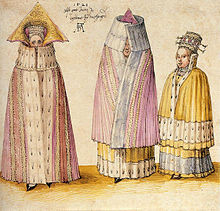Terra Mariana
Terra Mariana | |||||||||||||
|---|---|---|---|---|---|---|---|---|---|---|---|---|---|
| 1207–1561 | |||||||||||||
Confederation Agreement | 4 December 1435 | ||||||||||||
| 1561 | |||||||||||||
| |||||||||||||
| Today part of | Estonia Latvia | ||||||||||||
Terra Mariana (
The
Throughout the existence of medieval Livonia there was a constant struggle over supremacy, between the lands ruled by the Church, the Order, the secular German nobility, and the citizens of the
In 1561, during the
History
Livonian Crusade
The lands on the eastern shores of the
This crusade differed from many other crusades because, in this case, the Pope allowed people intending to go on a crusade to the Holy Land to go instead to crusade in Livonia. Members of this crusade were made to wear the insignia of the cross as well, which showed that they were legally bound to the crusade.[13]
After the success of the crusade, the German- and Danish-occupied territory was divided into feudal principalities by William of Modena.[14]
Establishment

This division of medieval Livonia was created by
]Medieval Livonia was intermittently ruled first by the Brothers of the Sword, since 1237 by the semi-autonomous branch of

In 1240
Livonian civil wars

Throughout the existence of medieval Livonia there was a constant struggle for superiority in the rule over the lands by the Church, the order, the secular nobles of German descent who ruled the fiefs and the citizens of the Hanseatic town of
The most important ally of the Livonian Order was the German nobility in the Danish Duchy of Estonia.
Livonian Confederation
The Teutonic Order fell into decline after Poland and Lithuania defeated it in the Battle of Grunwald in 1410. The Livonian Order managed to maintain an independent existence, as it did not participate in the battle and suffered no casualties, having obtained a truce with Grand Duke Vytautas.[19]
In 1418 Pope Martin V nominated Johannes Ambundii to the position of Archbishop of Riga.[20] He became known as the organizer of the Livonian confederation.[21][22]
Conflict commonly occurred between the Order, the bishops, and the powerful Hanseatic cities throughout the existence of medieval Livonia. To solve internal disputes, the Livonian Diet or Landtag gathered in 1419[23][24] at the initiative of Archbishop Ambundii. The city of Walk was chosen as the site of the Diet. The Diet comprised members of the Livonian Order, Livonian Bishops, vassals and city representatives.[23]
On 1 September 1435 the Livonian Order's defeat in the Battle of Wiłkomierz, claiming the lives of the Master and several high-ranking knights, brought the order closer to its Livonian neighbours. The Livonian confederation agreement (eiine fruntliche eyntracht) was signed in Walk on 4 December 1435, by the archbishop of Riga, the bishops of Courland, Dorpat, Ösel-Wiek and Reval; the representatives of the Livonan Order and vassals, and the deputies of Riga, Reval and Dorpat city municipal councils.[25]
The states of the Livonian Confederation ceased to exist during the
In 1561 a Swedish army landed in
| |
|
Nomenclature
According to
"Sicut", inquit, "pater sancte, terram sanctam Ierosolimitanum, que est terra filii, sanctitatis tue studio fovere non desinis, sic Lyvoniam, que est terra matris, [...] derelinquere non debes." "Holy Father", he said, "as you have not ceased to cherish the Holy Land of Jerusalem, the country of the Son, [...] so also you ought not to abandon Livonia, the land of the Mother [...][30]
In popular culture
"Terra Mariana" appears as an achievement in the historical strategy video game Europa Universalis IV.[31]
See also
Notes
- ^ In administrative and liturgical use
- Livonian Governoratethat was formed from part of its territories after its breakup.
References
- ^ a b "Terra Mariana". The Encyclopedia Americana. Americana Corp. 1967.
- ISBN 9780817928537.
- ISBN 9780810875135.
- : Livonija)
- ^ Bilmanis, Alfreds (1944). Latvian-Russian Relations: Documents. The Latvian legation.
- ^ Herbermann, Charles George (1907). The Catholic Encyclopedia. Robert Appleton Company.
- ^ Bilmanis, Alfreds (1945). The Church in Latvia. Drauga vēsts.
1215 proclaimed it the Terra Mariana, subject directly.
- ^ ISBN 0-14-026653-4.
- ISBN 0-521-47299-7.
- ^ The Order of the Cross of Terra Mariana. President of the Republic of Estonia, Estonian State Decorations. Retrieved 2011-01-22
- ^ "Māras zeme | Tēzaurs". tezaurs.lv. Retrieved 2024-03-07.
- ISBN 0-313-33125-1.
- ^ a b c Brundage, James. Thirteenth-Century Livonian Crusade: Henricus De Lettis and the First Legatine Mission of Bishop William of Modena. Franz Steiner Verlag. pp. 1–9
- ^ a b William Urban.An Historical Overview of the Crusade to Livonia.
- ISBN 9780817993030.
- ISBN 87-88073-30-0.
- ^ ISBN 0-8191-1683-1.
- ^ Skyum-Nielsen (1981), p. 129.
- ^ Christiansen (1997), p. 227.
- ISBN 3-11-012057-7.
- ISBN 978-1-4067-2870-5.
- ISBN 9780313323553.
- ^ ISBN 0-8179-9302-9.
- ISBN 0-8108-4904-6.
- ISBN 978-9949-415-84-7.
- ISBN 9781576078006.
- ^ Vane, Charles William (1838). Recollections of a tour in the north of Europe in 1836–1837. p. 178.
- ISBN 90-6550-881-3.
- ^
Plakans, Andrejs (2011). A Concise History of the Baltic States. Cambridge University Press. p. 95. ISBN 978-0-521-54155-8.
- ^
Jensen, Carsten Selch (2009). "8: How to Convert a Landscape: Henry of Livonia and the Chronicon Livoniae". In Murray, Alan V. (ed.). The Clash of Cultures on the Medieval Baltic Frontier. Farnham, Surrey: Ashgate Publishing, Ltd. p. 165. ISBN 9780754664833. Retrieved 2017-07-12.
'Holy Father', he said, 'as you have not ceased to cherish the Holy Land of Jerusalem, the country of the Son, [...] so also you ought not to abandon Livonia, the land of the Mother [...]' [...] Sicut, inquit, 'pater sancte, terram sanctam Ierosolimitanum, que est terra filii, sanctitatis tue studio fovere non desinis, sic Lyvoniam, que est terra matris, [...] derelinquere non debes. [...]'
- ^ "Steam Community :: Europa Universalis IV :: Achievements". steamcommunity.com. Retrieved 2021-08-13.




